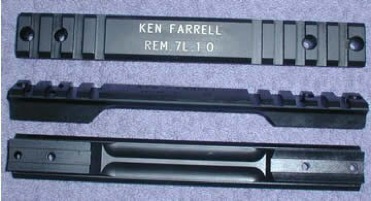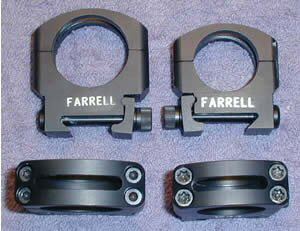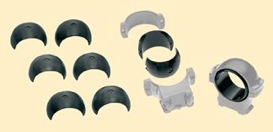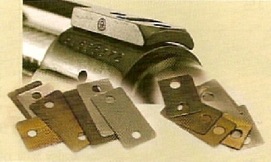
For some strange reason I thought I should change it to a sloped single piece mount but left it alone until I got close to doing a workup on a second rig. Then I though maybe now’s the time to consider a change. I justified it by thinking if I rig the mount(s) right then I could move a scope back and forth between the two rigs. Good long range target scopes are expensive and depending on rifle could be a third to ½ the total cost of your rig. The scopes I now prefer are Leupolds and Nightforce. The rest of the brands I’ll leave them for you to play around with including the Tascos.

I looked at the alternatives and finally decided on the Ken Farrell Long Range Bases. They were available with a 20 MOA taper, you could get them for the Remington 700 short action in weaver style. Ken also makes rings so I got a set of them for 30mm. I also got the 4 screw types rather than the two screw. No reason for 2 over 4 I hadn’t done or read any definitive studies on it. Just figured 4s better. TPS rings & bases are good too!
The odds were with me in the alignment process for the single piece bases and the rings and the scope… didn’t have to get into the lapping part of the process. This was with both my Remington 700 short actions so maybe double lucky?
I definitely recommend you check closely you may need to lap be a real shame if you over look the possibility of having to do it.
I took both rigs to the range. One of them had the scope mounted the other just the base. I zeroed the rifle did some tests and was satisfied with the results. I then made notes on where it was positioned took the scope off and mounted it on the second rig. Zeroed it did some tests and made notes on where it was positioned on the second rig. I then swapped it back to the first rig and did some more tests. There really wasn’t much of a shift returning it to the first rig. I was pretty happy with the results overall. Would I do a swap in the middle of a long distance match? Probably not if I could avoid it but if push came to shove the option is there.
I like the setup it adds a sameness to both rigs and that’s what I wanted.


I have a story that Art Grundy is never going to let go. I was in a hurry and needed a shim badly. I had one made up and shipped express for me hoping it would arrive in time for a match coming up on the weekend. It never did arrive in time! Cost was close to 40 bucks for the shim! I wasn’t on any kind of medication at the time but I could have used some afterwards. You can avoid something like this by simply going to a local hardware or automotive store and getting a cheap set of brass feeler gauges. Get the brass type because it’s easy to drill the required holes than trying to drill the stainless steel type. It’s a softer metal and feeler gauges do come in brass because it’s non-magnetic and the car jocks can tell you why that’s important. A bunch of gauges are usually held together with a rivet or fastener and you can find one that’s close or a combination of a couple. Try finding one thickness that’s close then you’re only dealing with one piece and drilling two holes, not 2 pieces and drilling 4 holes and having alignment problems between the two.
I’ve avoided detailing a bunch of dimensional stuff because there are so many combinations of bases, rings and scopes out there. You need to sit down and methodically work through the clearance issues you may face with such things as tube diameters like 1” or 30mm, that’s a simply one. Then you have the diameter of the front bell it has to obviously clear the barrel. You have to consider the thickness or height of the base in addition to or with the combination of the height of the rings themselves as in low, medium and high profiles. You can figure this out yourself, enlist the help of a buddy who already has a setup you want or take it all to a gunsmith who is more than capable of working this all out for you. It also includes such things as eye relief. I also didn’t get into the type of metals aluminum, steel, hardened or titanium your choice.
If you’re going to do the mounting yourself one other caution I will make is in reference to small slotted screws. I avoid them like the plague but a lot of bases and rings make use of them. I much prefer the beveled Torx 6-48 screws and key arrangements and Ken’s bases include 4 beveled screws. Just make darn sure you use a flat bladed screw driver that is flat right out to the very edges. If it has any kind of radius or round appearance near the edges I’ll guarantee you it will slip when you torque the screws. It only takes one slip on one screw to mess up a perfectly simple install. I’ve seen it it’s not pretty!
With regards to which scope to use I’ve mentioned two. I’m sure there are number of others. The two mentioned are expensive scopes. What you need is something that allows you to see the Vee or X at 1000 yards if you’ll be shooting out to that distance. If you plan on shooting tactical or precision type matches you might want to talk to the guys who shoot it and get their feedback. Some say you need nothing more than 20 power. When I started I used a fixed 36X power scope for more than a year. They feel if you go much higher you’ll have problems with heavy mirage. With a side-focusing variable you can dial it back down and you can play with the focus to check mirage further away from the target. It’s quick and it’s fast. In our f-class we have 45 seconds to get the shot off. If your single stringing that’s a different story. With the focusing mechanism on the front you have to reach forward to get at it which takes you out of position. The front bell approach may prevent you from running into any side focus issues with shifting POA.
Then there’s the choice of reticles. Some like mil-dots, some have reticles that look like Christmas trees way too much information being thrown at you. Some like a dot included at the intersection of the crosshairs. Some have very thick crosshairs and some very fine. Thick covers things up and too fine under certain light conditions they’re difficult to see. Are you a clicker or do you hold over? Some additional hash marks might work but then you need to remember which one you were holding on. There has been some discussion on variables shifting point of aim when zooming in and out and the amount varies. Focus at 100 yards on highest power on the centre of a target then zoom out. Do the cross hairs move in any direction? One thing I try to avoid in a string is changing powers through any part of the relay. If mirage is getting strong then make your changes before you shoot your sighters. That way you’ll still have your POA. A scope is a big ticket purchase and it’s amazing the number of people who make the purchase without even looking through a bunch. There’s other decisions resolution, image contrast, eye relief, exit pupil and the most important one tracking or trackability or repeatability in tracking. This one will get you into more trouble than all the others combined. Talk to the shooters who shoot what you want to shoot before you open your wallet. Spend a bit of time making this decision. If you’re hooked up to the internet and I don’t know many who aren’t these days do some searches in some of the shooting conferences but stay away from the advertisements for the obvious reasons. Some sites like www.6mmbr.com offer side by side comparisons. Might be worth checking out.
My application of a scope is a simple one. I shoot one discipline and it’s long range f-class. I looked at what the guys were using on the line as part of the process I checked their scores. I talked to a bunch of them and I asked to look through some of their scopes during practices from the 1000 yard line, then I got out the credit card.